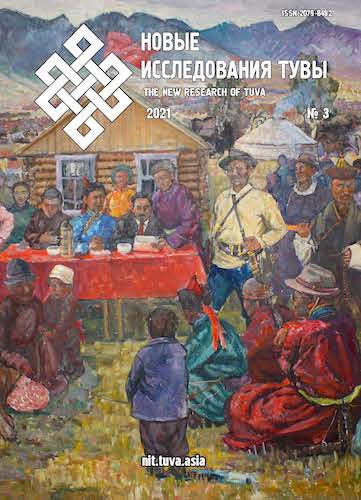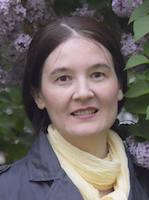Semantic analysis of Tuvan proverbs: models, imagery, concepts (against the European paremiological background)
DOI:
https://doi.org/10.25178/nit.2021.3.17Keywords:
paremiology; proverb; semantics; structural and semantic models; key concepts; imagery in proverbs; Tuvan language; Tuvan folklore; modern European languageAbstract
As it is with all other languages, Tuvan proverbs have a certain ethnic and cultural character, which manifests itself both in the presence of specific language units (proverbs endemic for the Tuvan language) and in the local versions of the paremias which also exist in other language (universal, international or borrowed proverbs). In both linguocultural and typological aspects, the most urgent and hence the most difficult thing is to outline the common features and ethnically and culturally determined differences between the proverbs in Tuvan and modern European languages.
Our study focuses on the semantic analysis of Tuvan proverbs upon the wide background of European languages – Slavic, Baltic, Germanic and Romance. We aim to define the principal factors of describing the ethnocultural specificity of Tuvan proverbs – on the level of paremiological models, key terms and imagery (as different from those of modern European languages). The sources for comparison came from published editions of Tuvan proverbs and sayings, and polylingual paremiological dictionaries, such as “The Dictionary of European Proverbs” by E. Strauss (1994), «European Proverbs in 55 Languages, with Equivalents in Arabic, Persian, Sanskrit, Chinese, and Japanese» by D. Paczolay (1997).
The authors examine the Tuvan proverbs which have their counterparts in European languages (i.e. cases of common proverbial models of various types). These proverbs use the imagery identical or close to their European counterparts and have analogical key concepts (in the sociocultural, axiological or empirical sense, also known as cognitemes. Also differentiated are the models, imagery and notions in Tuvan proverbs which contain paremiological code of various types – natural, animalistical, somatic, gastronomical, etc. – and have appeared due to cultural transfer or linguocultural assimilation.
We have concluded that most of the Tuvan proverbs which share models, imagery and notions with proverbs in European language possess both linguistic and ethnocultural characteristics of its own, including ethnic semantic models, ethnocultural versions of imagery and ethnolinguistically and ethnoculturally determined connotations of key notions.
We have proved that semantic analysis of proverbial models, imagery and key concepts can help comprehensively differentiate between the common and the specific in the corpus of Tuvan proverbs. This is of paramount importance for both linguocultural typology of Tuvan proverbs and identifying ethnocultural specificity of Tuvan proverbial corpus as compared with those of other languages and cultures.
References
Bolat-ool, R. V. and Pelevina, N. N. (2017) Formirovanie obraza zhenshchiny v tuvinskikh i nemetskikh poslovitsakh [The woman in Tuvan and German proverbs]. Vestnik Khakasskogo gosudarstvennogo universiteta im. N. F. Katanova, no. 21, pp. 29–32. (In Russ.).
Bredis, M. A., Lomakina, O. V. and Mokienko, V. M. (2020) Rusinskaia frazeologiia kak primer kul'turno-iazykovogo transfera v slavianskikh iazykakh (na materiale numerativnykh edinits) [Rusin phraseology as an example of cultural and linguistic transfer in Slavic languages: the case of numerative units]. Rusin, no. 60, pp. 198–212. (In Russ.). DOI: https://www.doi.org/10.17223/18572685/60/12
Bredis, M. A., Dimoglo, M. S. and Lomakina, O. V. (2020) Paremii v sovremennoi lingvistike: podkhody k izucheniiu, tekstoobrazuiushchii i lingvokul'turologicheskii potentsial [Paremias in modern linguistics: Approaches to studying and its text-building and linguocultural potential]. RUDN Journal of Language Studies, Semiotics and Semantics, vol. 11, no. 2, pp. S. 265–284. (In Russ.). DOI: https://www.doi.org/10.22363/2313-2299-2020-11-2-265-284
Budegechieva, T. B. (2018) Tuvinskaia kul'tura: material'noe i dukhovnoe, traditsii i novatsii [Tuvan culture: material and spiritual, traditions and innovations]. Kyzyl, TuvSU Publ. 115 p. (In Russ.).
Burykin, A. A., Boldyreva, I. M. and Muzraeva, D. N. (2019). Sobaka v kalmytskom i tuvinskom fol'klore [The dog in Kalmyk and Tuvan folklore]. New Research of Tuva, no. 4, pp. 119–132. (In Russ.). DOI: https://www.doi.org/10.25178/nit.2019.4.10
Vinokur, G. O. (1990) Poniatie poeticheskogo iazyka [The concept of poetic language]. In: Filologicheskie issledovaniia: lingvistika i poetika [Philological studies: linguistics and poetics] / ed. by G. V. Stepanov and V. P. Neroznak. Moscow, Nauka. 451 p. Pp. 140–145. (In Russ.).
Dorzhu, K. B. (2012) Sravneniia v russkikh i tuvinskikh pogovorkakh, poritsaiushchikh otritsatel'nye kachestva cheloveka [Comparisons in Russian and Tuvan proverbs which condemn negative personal qualities]. Vestnik Tuvinskogo gosudarstvennogo universiteta, no. 1, pp. 94–98. (In Russ.).
Dorzhu, K. B. (2016) Ispol'zovanie frazeologizmov, sviazannykh s priemom pishchi, v romane Salima Siuriun-oola «Tyvalaar kuskun» [The use of eating-related phraseological units in the novel “Tyvalaar kuskun” by Salim Surun-ool]. Mir nauki, kul'tury, obrazovaniia, no. 5(60), pp. 352–354. (In Russ.).
Dulichenko, A. D. (1981) Slavianskie literaturnye mikroiazyki: voprosy formirovaniia i razvitiia [Slavic literary microlanguages: problems of formation and development]. Tallinn, Valgus. 323 p. (In Russ.).
Egorova, A. I., Kondakova, A. P. and Kuzhuget, M. A. (2020) Gendernye stereotipy v tuvinskikh poslovitsakh i pogovorkakh [Gender stereotypes in Tuvan proverbs and sayings]. New Research of Tuva, no. 1, pp. 18–31. (In Russ.). DOI: https://www.doi.org/10.25178/nit.2020.1.2
Zhukov, V. P. (2003) Slovar' russkikh poslovits i pogovorok [A dictionary of Russian proverbs and sayings]. Moscow, Russkii iazyk — Media. 544 p. (In Russ.).
Ivanov, E. E. (2019a) Aspekty empiricheskogo ponimaniia aforizma [Aspects of empirical understanding of aphorisms]. RUDN Journal of Language Studies, Semiotics and Semantics, vol. 10, no. 2, pp. 381–401. (In Russ.). DOI: https://www.doi.org/10.22363/2313-2299-2019-10-2-381-401
Ivanov, E. E. (2019b) O rekurrentnosti aforisticheskikh edinits v sovremennom russkom iazyke [Aphoristic units and their recurrence in modern Russian language]. Russian Language Studies, vol. 17, no. 2, pp. 157–170. (In Russ.). DOI: https://doi.org/10.22363/2618-8163-2019-17-2-157-170
Ivanov, E. E. (2020) Aforizm kak ob"ekt lingvistiki: osnovnye priznaki [Aphorism as an Object of Linguistics: the Main Properties]. RUDN Journal of Language Studies, Semiotics and Semantics, vol. 11, no. 4, pp. 659–706. (In Russ.). DOI: https://www.doi.org/10.22363/2313-2299-2020-11-4-659-706
Іvanova, S. and Іvanoў, Ya. (1997) Sloўnіk belaruskіkh prykazak, prymavak і krylatykh vyrazaў [A dictionary of Belarusian proverbs, sayings and winged expressions]. Mіnsk, BFS. 262 s. (In Bel.)
Іvanoў, Ya. Ya. (2011) Paremіialagіchnyia sіstemy belaruskai і ruskai moў: padabenstvy і razykhodzhannі [The paremiological systems of the Belarusian and Russian languages: similarities and differences]. Fіlologіchnі studіï, vol 6, part 2, pp. 53–63. (In Bel.)
Kechil-ool, S. V. and Saaia, O. M. (2016) Osobennosti frazeologizmov s komponentom «ukho» v tuvinskom iazyke v sopostavlenii s russkim [Phraseological units with the component “Ear” in the Tuvan language in comparison with the Russian]. Philology. Theory & Practice, no. 9–2(63), pp. 107–109. (In Russ.).
Kechil-ool, S. V. and Saaia, O. M. (2017) Semanticheskie osobennosti frazeologizmov s komponentom «ruka» v tuvinskom i russkom iazykakh [The semantic peculiarities of phraseological units with the component “Hand” in the Tuvan and Russian languages]. Philology. Theory & Practice, no. 6–1(72), pp. 92–95. (In Russ.).
Koniashkin, A. M. and Chadamba, Sh. S. (2014) O nekotorykh osobennostiakh vvedeniia paremii v khudozhestvennyi tekst (na materiale russkikh perevodov) [On some features of introducing Tuvan proverbs into a literary text: the case of Russian translations]. Mir nauki, kul'tury, obrazovaniia, no. 3(46), pp. 200–202. (In Russ.).
Koniashkin, A. M. and Chadamba, Sh. S. (2014) Problema perevoda tuvinskikh paremii (na materiale russkikh khudozhestvennykh perevodov) [The problem of translating Tuvan paroemias: the case of Russian literary translation]. Mir nauki, kul'tury, obrazovaniia, no. 3(46), pp. 202–204. (In Russ.).
Koniashkin, A. M. and Chadamba, Sh. S. (2017) Lingvokul'turologicheskii aspekt tuvinskikh paremii v tekstakh russkikh khudozhestvennykh perevodov [Linguoculturological aspect of the Tuva paremias in texts of the Russian literaly translations]. Mir nauki, kul'tury, obrazovaniia, no. 6 (67), pp. 616–618. (In Russ.).
Kotova, M. Yu. (2000) Russko-slavianskii slovar' poslovits (s angliiskimi sootvetstviiami) [Russian-Slavic dictionary of proverbs (with English correspondences)]. St. Peterburg, SPbSU Publ. 360 p. (In Russ.).
Lamazhaa, Ch. K. (2015) Rebenok i detstvo v tuvinskoi kul'ture: traditsii i sovremennost' [The child and childhood in the Tuvan culture: traditions and modernity]. Chelovek, no. 4, pp. 51–58. (In Russ.).
Levin, Yu. I. (1984) Proverbial'noe prostranstvo [Proverbial space]. In: Paremiologicheskie issledovaniia [Paremiological studies] / comp. by G. L. Permiakov. Moscow, Nauka. 320 p. Pp. 108–126. (In Russ.).
Lepeshaў, І. Ia. (2006) Paremіialogіia iak asobny razdzel movaznaўstva [Paremiology as a separate branch of linguistics]. Grodna, GrDU іmia Iankі Kupaly. 279 p. (In Bel.)
Lepeshaў, I. Ya. and Yakaltsevіch, M. A. (2011) Tlumachal'ny sloўnіk prykazak [Explanatory dictionary of proverbs]. Grodna, GrDU іmia Iankі Kupaly. 695 p. (In Bel.)
Lingvisticheskii entsiklopedicheskii slovar' [Linguistic Encyclopedic Dictionary] (1990) / ed. by V. N. Iartseva. Moscow, Sovetskaia entsiklopediia. 685 p. (In Russ.).
Lomakina, O. V. and Mokienko, V. M. (2018) Tsennostnye konstanty rusinskoi paremiologii (na fone ukrainskogo i russkogo iazykov) [Value constants of the Rusin paremiology as compared with the Ukrainian and Russian languages]. Rusin, no. 4(54), pp. 303–317. (In Russ.). DOI: https://www.doi.org/10.17223/18572685/54/18
Matveeva, T. V. (2010) Polnyi slovar' lingvisticheskikh terminov [A complete dictionary of linguistic terms]. Rostov-na-Donu, Feniks. 562 p. (In Russ.).
Mokienko, V. M. (1989) Slavianskaia frazeologiia [Slavic phraseology]. Moscow, Vysshaia shkola. 287 p. (In Russ.).
Mokienko, V. M., Nikitina, T. G. and Nikolaeva, E. K. (2010) Bol'shoi slovar' russkikh poslovits [A grand dictionary of Russian proverbs]. Moscow, OLMA Media Grupp. 1024 p. (In Russ.).
Neliubova, N. Yu. (2019) Sem'ia kak obshchechelovecheskaia tsennost' vo frantsuzskoi i russkoi poslovichnoi kartine mira [The family as a universal value in the French and Russian proverbial picture of the world]. Philological Sciences. Scientific Essays Of Higher Education, no. 6, pp. 50–59. (In Russ.).
Neliubova, N. Iu., Semina, P. S. and Kazlauskene, V. (2020) Gurmanstvo v ierarkhii tsennostei frantsuzov i bel'giitsev (na materiale poslovits i pogovorok) [Gourmandise in the hierarchy of values: A case study of French and Belgian proverbs and sayings]. Russian Journal of Linguistics, vol. 24, no. 4, pp. 969–990. (In Russ.). DOI: https://www.doi.org/10.22363/2687-0088-2020-24-4-969-990
Neliubova, N. Yu., Khil'tbrunner, V. I. and Ershov, V. I. (2019) Otrazhenie ierarkhii tsennostei v poslovichnom fonde russkogo i frantsuzskogo iazykov [The reflection of the hierarchy of values in the proverbial fund of the Russian and French languages]. Russian Journal of Linguistics, vol. 23, no. 1, pp. 223–243. (In Russ.). DOI: https://www.doi.org/10.22363/2312-9182-2019-23-1-223-243
Paremiologiia bez granits [Paremiology without borders] (2020) / ed. by M. A. Bredis and O. V. Lomakina. Moscow, RUDN Publ. 244 p. (In Russ.).
Paremiologiia v diskurse [Paremiology in Discourse] (2015) / ed. by O. V. Lomakina. Moscow, URSS; Lenand. 294 p. (In Russ.).
Petrushevskaia, Yu. A. (2015) Universal'noe i natsional'noe v paremiologicheskoi sisteme iazyka (na materiale angliiskogo i belorusskogo iazykov) [The universal and national in the paremiological system of the language: The case of English and Belarusian languages)]. Acta Germano-Slavica, vol. 6, pp. 213–216. (In Russ.).
Petrushevskaia, Yu. A. (2021) Metodologiia opredeleniia natsional'nogo, internatsional'nogo i universal'nogo v frazeologii i paremiologii belorusskogo iazyka [Methodology for determining the national, international and universal in the phraseology and paremiology of the Belarusian language]. West — East, vol. 5, no. 1, pp. 61–72. (In Russ.).
Petrusheўskaia, Yu. A. (2020) Unіversal'ny і іnternatsyianal'ny kampanenty ў paremіialagіchnym skladze belaruskai movy: belaruska-іnshamoўny sloўnіk [Universal and international components in the poremiological composition of the Belarusian language: Belarusian-foreign language dictionary]. Magіleў, MDU. 312 p. (In Bel.)
Poliakov, O. Yu. and Poliakova, M. O. (2016) Lingvisticheskie modeli angliiskikh poslovits: strukturno-tipologicheskii aspekt [Linguistic models of English proverbs: the structural and typological aspect]. Vestnik Viatskogo gosudarstvennogo universiteta, no. 1, pp. 65–70. (In Russ.).
Salchak, A. M. (2019) Obraz volka v tuvinskikh i angliiskikh poslovitsakh [The wolf in Tuvan and English proverbs]. Simvol nauki: mezhdunarodnyi nauchnyi zhurnal, no. 6, pp. 25–27. (In Russ.).
Suvandii, N. D. (2019) Toponimy-tsvetooboznacheniia v tuvinskom iazyke [Place names of color designation in Tuvan language]. New Research of Tuva, no. 4, pp. 195–206. (In Russ.). DOI: https://www.doi.org/10.25178/nit.2019.4.16
Frazeologiia [Phraseology] (1972) // Obshchee iazykoznanie. Vnutrenniaia struktura iazyka [General linguistics. Internal structure of the language] / ed. by B. A. Serebrennikov. Moscow, Nauka. 564 p. Part 7. Pp. 456–515. (In Russ.).
Chadamba, Sh. S. (2014) O nekotorykh osobennostiakh perevoda predlozhenii-paremii v tekstakh russkikh khudozhestvennykh perevodov s tuvinskogo iazyka [Some features of the translation of paroemian sentences in the texts of Russian literary translations from the Tuvan language]. Philology. Theory & Practice, no. 5–1(35), pp. 191–193. (In Russ.).
Chadamba, Sh. S. (2015) Predlozheniia-paremii v tekstakh russkikh khudozhestvennykh perevodov s tuvinskogo iazyka [Sentences-paroemias in the texts of Russian literary translations from the Tuvan language]: Diss. … Candidate of Philology. Abakan. 151 p. (In Russ.).
Chugunekova, A. N. (2019) Simvolika chisel v khakasskoi i tuvinskoi paremiologii [Symbolism of numbers in Khakass and Tuvan paremiology]. Mezhdunarodnyi zhurnal gumanitarnykh i estestvennykh nauk, no. 10–2(37), pp. 18–21. (In Russ.).
Yazyk i struktury predstavleniia znanii [Language and structures of knowledge representation] (1992) / ed. by F. M. Berezin and E. S. Kubriakova. Moscow, INION. 162 p. (In Russ.).
Anderson, J. R. and Bower, G. H. (1973) Human associative memory. Washington, DC, Winston & Sons. 524 p.
Grigas, K. (1987) Patarlių paralelės. Lietuvių patarlės su latvuių, baltarusių, rusų, lenkų, vokiečių, anglų, lotynų, prancūzų, ispanų, atitikmenimis. Vilnius, Leydykla Vaga. 662 p. (In Lithuanian)
Ivanov, E. (2016) Aphorism as a Unit of Language and Speech. In: EUROPHRAS 2016: Word Combinations in the Linguistic System and Language Use: Theoretical, Methodological and Integrated Approaches. Trier, University of Trier. 128 p. P. 42.
Ivanov, E. (2002) Paremiological Minimum and Basic Paremiological Stock (Belarusian and Russian). Prague, RSS. 136 p.
Ivanov, E. and Feldman, V. (2007) Principles of the Contrastive Description of Aphoristic Paremiology (in Belarusian and Russian Languages). Acta Germano-Slavica, vol. 1, pp. 85–97.
Ivanov, E. and Petrushevskaia, Ju. (2015) Etymology of English Proverbs. Journal of Siberian Federal University. Humanities & Social Sciences, vol. 8, no. 5, pp. 864–872.
Lomakina, O. V. (2021) Concepts of god and faith in Uzbek and Tajik proverbs in terms of culture and language transfer theory. European Journal of Science and Theology, vol. 17, no. 2, pp. 125–135.
Muñoz, J. S. (2001) 1001 refranes españoles con su correspondencia en ocho lenguas (alemán, árabe, francés, inglés, italiano, polaco, provenzal y ruso). S. A. Eiunsa, Ediciones Internacionales Universitarias. 444 p. (In Spanish)
Paczolay, G. (1997) European Proverbs in 55 Languages, with Equivalents in Arabic, Persian, Sanskrit, Chinese, and Japanese. Veszprém (Hungary), Veszprémi Nyomda. 528 p.
Semenenko, N. N., Lisitsyna, G. A., Voronkova, O. A. and Osadchay, M. N. (2015) Stereotypic model in the focus of the value paroemia representation. The Social Sciences, vol. 10, no. 6, pp. 1170–1172.
Strauss, E. (1994) Dictionary of European Proverbs. Vol. 1–3. London & New York, Routledge. Vol. 1. 625 p. Vol. 2. 627–1232 p. Vol. 3. 789 p.
Świerczyńska, D. and Świerczyński, A. (1998) Słownik przysłów w ośmiu językach. Warzsawa, Wydawnictwo Naukowe PWN. 437 s. (In Polish).
Published
How to Cite
For citation:
Ivanov E. E., Lomakina O. V. and Nelyubova N. Yu. Semanticheskii analiz tuvinskikh poslovits: modeli, obrazy, poniatiia (na evropeiskom paremiologicheskom fone) [Semantic analysis of Tuvan proverbs: models, imagery, concepts (against the European paremiological background)]. New Research of Tuva, 2021, no. 3, pp. 232-248. (In Russ.). DOI: https://www.doi.org/10.25178/nit.2021.3.17
Issue
Section

This work is licensed under a Creative Commons Attribution-NonCommercial 4.0 International License.

Author(s) license holder(s) grant rights for their work to the journal (grantee of a license) under the simple non-exclusive open license in accordance with Art. 1286.1 «Open license for a research work, work of literature or fine arts», Civil Code of the Russian Federation.
New Research of Tuva publishes articles under the Creative Commons Attribution-NonCommercial license (CC BY-NC).
Since it is an open license, author(s) reserve the right to upload the article to their institutional repository, submit it to another journal (if it allows republications), or republish it on their own website (in full, or in part).
However, several conditions apply here:
a) The republished version must always contain the name(s) and affiliation(s) of the author(s), the original title and the hyperlink to the original version on the New Research of Tuva website;
b) It must be in open access, free of charge, and no category of readers must be in any way whatsoever advantaged over general readership.
c) should the contribution be submitted elsewhere by its author(s) without substantial modification (30% or more of original text unchanged), the body of the article should contain a disclaimer that the original version was published in New Research of Tuva (with a link to the respective page)
The CC-BY-NC is a non-revocable license which applies worldwide and lasts for the duration of the work’s copyright.











